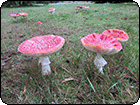 photo by splunge
photo by splunge
 photo by TheophileEscargot
photo by TheophileEscargot
 photo by Kronos_to_Earth
photo by Kronos_to_Earth
 photo by ethylene
photo by ethylene
Comment Feed:
♦ RSS
Learning how to taste wines is a straightforward adventure that will deepen your appreciation for both wines and winemakers. Look, smell and taste - starting with your basic senses and expanding from there you will learn how to taste wines like the pros in no time!
Look Pour a glass of wine into a suitable wine glass. Then take a good look at the wine. What color is it? Look beyond red, white or blush. If it's a red wine is the color maroon, purple, ruby, garnet, red or even brownish. If it's a white wine is it clear, straw-like, golden, light green, pale yellow or brown in appearance?
Still Looking. Move on to the wine's opacity. Is the wine clear, cloudy, transparent or opaque? Tilt your glass a bit, give it a little swirl - look again, you are looking at color, clarity, brilliance (sounds like you're finding the perfect diamond!) - is there sediment, bits of cork or any other floating bits? An older red wine will be more translucent than younger red wines.
Smell Our sense of smell is critical in properly analyzing a glass of wine. To get a good impression of your wine's aroma, gently swirl your glass (this will enhance the wine's natural aromas) and then take a quick whiff to gain a first impression.
Still Smelling. Now stick your nose down into the glass and take a deep inhale through your nose. What are your second impressions? Do you smell oak, berry, flowers, vanilla or citrus? A wine's aroma is an excellent indicator of its quality and unique characteristics. Gently swirl the wine and let the aromas mix and mingle, and sniff again.
Taste Finally, take a taste. Start with a small sip and let it roll around your tongue. There are three stages of taste:
Taste - After gathering your initial impression of the wine, allow a small breath of air in through your lips and allow the wine to mingle with the air (called swirling). This will allow you to taste flavors more fully (even if you look or sound a bit funny). What do you taste? Reds will often have berry, woody and bell pepper tastes. White wines will often have apple, floral or citrus flavors associated with them.
Initial Taste - This is your first impression of the wine's components and flavors.
Finish - The wine's finish is how long the flavor lasts after it is swallowed. Did it last several seconds? Was it light-bodied (like water) or full-bodied (like the consistency of milk)?
After you have taken the time to taste your wine, you might record some of your impressions. Did you like the wine overall? Does it taste better with cheese, bread or a heavy meal? Will you buy it again? If so, jot the wine's name, producer and year down for future reference.
Alpana says that all wine (with some exceptions of course) can be placed into one of six categories. If you understand these categories, you can understand most wine and how to pair it with food. Here are my half-remembered notes.
Whites
Light whites - e.g., pinot grigio - light in color; tend to taste like green fruits (green apples, green tomatoes, grapefruit, etc); tart or citrusy; dry (not sweet); foods that taste good with a squeeze of lemon will taste good with these wines - like fish, etc.
Sweet whites - e.g., riesling - also fruity but obviously sweet; pair with salty foods to get that salty-sweet combo, or hot-spicy foods to cool down the heat.
Heavy whites - e.g., chardonnay - dark and buttery in color and flavor; pair with things that would taste good with butter.
Reds
Light reds - e.g., pinot noir - lighter in color because they come from thin-skinned grapes; tend to taste like red fruits (strawberries, cherries, red apples, pomegranates, etc.); pair with things that taste good with red fruits. A classic pairing is with duck for example (just like you'd have a cherry sauce with duck). Light reds are good as a bridge - if your group wants to buy a bottle but everyone is eating something different, chances are a pinot noir will taste good with everything.
Spicy reds - e.g., syrah - medium in color; have spiced flavors like cracked pepper, cloves, etc.; pair with heavily spiced (but not necessarily hot-spicy) foods like a peppercorn-crusted filet. The spicy reds also taste good with long-roasted foods like osso bucco or pot roast because you often use a spicy red in making them.
Heavy reds - e.g., cabernet - very dark in color because they come from thick skinned grapes; tend to taste like very dark inky colored fruits (blueberries, blackberries, purple plums); "chewy," therefore pair with chewy foods like steak.
I really enjoyed learning this. Alpana shared that her personal philosophy about wine is that it should be an everyday food. It shouldn't be on this pedestal where people don't feel worthy or knowledgeable about it and are scared of it. Also, you like what you like and that's ok. If you don't like a wine rated as a 98 by some sommelier, it doesn't mean you're broken or you don't get it. It could be, in her words, that "he's a Pepsi person and you're a Coke person." If you do want to really get into wines you have to practice so your brain gets better at associating/identifying the smells and flavors.